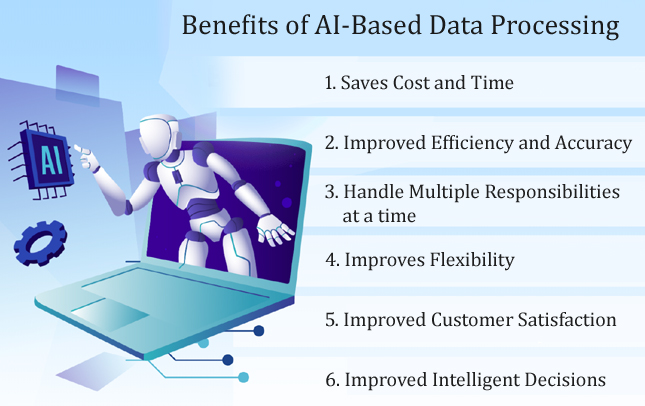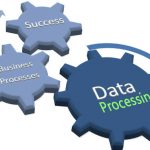Be it ordering food, making online financial transactions, searching on a particular topic, or any other task performed on the internet, every second, data is generated. The use of online carts, video streaming services, and social media has added to the increase in the total data generated. And to utilize this data and obtain necessary insights from such huge data, companies are now using AI for document processing.
Businesses are highly dependent on data processing services and consider it an essential part of digital transformation. Again, with the introduction of artificial intelligence, reading, categorizing, converting, and processing the data has become informal and accurate for improved data analysis.
Through this blog, let’s get into what is data processing, and how artificial intelligence has helped in improving the accurateness of the process.
What is Document Processing?

Every company comes across a huge database daily in the form of ID cards, invoices, emails, PDFs, contracts, receipts, medical documents, feedback forms, etc. But in its raw form, the database is insignificant for the company. With the data processing method, the raw data is collected and translated into operational information. The process is carried out by data engineers or data scientists who collect, filter, categorize, process, evaluate, store, and represent the data in a usable and readable layout.
Data processing method helps organizations to generate effective business strategies and compete in the market. When the database is converted into a readable format like charts, graphs, documents, etc., employees can easily understand the data and use it for various purposes.
Manual Data Processing – Is It Viable?

No doubt, the database is very crucial for any organization, but the entire data processing method is surely hectic if it is carried out manually. The companies come through a huge database daily, and when it is processed manually, errors might affect the accuracy of the database. Again, the entire process needs various resources which adds to the cost of the business.
So, what is the solution to all these challenges? The answer is AI document processing. For a brief understanding, scroll down and we shall upturn all the facts regarding Intelligent document processing.
How AI is Used for Document Processing

Artificial Intelligence has essentially changed the concept of data processing. Traditionally, data processing was carried out manually, that is through a manual data entry process. This was both fallible and laborious.
AI document processing is a method that includes Optical Character Recognition (OCR), Machine Learning (ML), and Natural Language Processing (NLP) to automate the extraction, classification, and authentication of data from various documents. AI based document processing is carried out with advanced tools that recognize and comprehend the meaning and context of the content in different formats like emails, PDFs, scanned images, and much more. This method reduces the chances of errors, and manual involvement, as well as improves the accuracy and processing time. Most of these advanced tools are based on Cloud, which authorizes flexibility and scalability.
With the involvement of automation in system integration, workflows, and reporting skills, AI handles important background functions that take document processing to an advanced level.
How Does AI Document Processing Work?

Here is a glimpse of how AI document processing is carried out:
- Document Intake
The foremost step in AI document processing is receiving documents. The documents are obtained through various sources like uploads, APIs, or even emails. They are typically in formats like emails, scanned images, and PDF files. When the file is uploaded, the system primarily performs an initial check to ensure the compatibility of the format and corruption-free layout. At times, physical documents might also be photographed or scanned to generate digital copies for data extraction. - Document Identification and Data Extraction
In the next step, the documents are identified to determine their type through machine learning models and analyzed. This helps in identifying documents like invoices, contracts, purchase orders, medical forms, etc. Once the classification of the documents is over, the system uses advanced algorithms powered by OCR or NLP to extract certain data points. The extracted data includes addresses, names, dates, product details, amounts, sales figures, or any kind of relevant information according to the type of document. - Data Validation and Error Recognition
When the data is finally extracted, the validation process is initiated. This step ensures the accuracy of the data. The process includes cross-checking the data, integrating the data with external data, or even acknowledging it with presumed rules for verification. The system can also identify human errors and automatically suggest accurate rectifications based on pre-established patterns of data. - Integration and Final Output
On completion of the data validation process, the final database is then faultlessly integrated into business systems like CRM or ERP software. This process doesn’t need manual data entry, as the entire process is carried out automatically to streamline the flow of information to various users of the company. With the help of a comprehensive interface, the users can easily have access to the database for preparing reports, further analysis, eliciting automated workflows, etc. - Document Routing
The job of AI is not only to extract data from various documents. Once the data is extracted, it might need a little post-processing to ensure its usability and accuracy. This might need human help to validate the data extracted, address any inconsistencies, and train various AI models for enhanced future performance. Furthermore, the data can also be normalized or formatted to ensure its seamless integration with the existing workflows or systems.
This was a simplified explanation of how AI document processing is carried out. It reduces the burden on the employees and empowers them to concentrate on other strategic initiatives.
Some Key Components and Technologies Used by AI
Here is the list of certain key technologies and components used during the AI document processing method:
- Machine Learning
Machine Learning, popularly termed ML trains various models for automated interaction with different document types. It trains the models constantly to extract desired data accurately, optimizing automation, and identifying patterns of the processes. ML is capable of handling huge data quantities for identifying document types and modifying their processing for particular layouts. - Deep Learning
Another sub-part of ML, Deep Learning also helps in the process of AI document management. It helps with data extraction from various documents. However, the algorithms it works on make the process time-consuming. Again, it also needs various resources for extraction as well as training purposes. Sadly, Deep Learning is rarely used as it infringes on privacy. - Computer Vision
As the name suggests, computer vision functions the visual data from documents like watermarks, images, signatures, logos, etc. Through different algorithms, it extracts visual elements and organizes documents. Along with OCR, it helps in improving the characterization of the entire document. - Natural Language Processing
Also termed as NLP, this tool helps computers to read human language. It teaches the machines or computers to produce human language as well as process complex language structures. They are capable of understanding the names or even the addresses mentioned in the given unstructured database. - Robotic Process Automation
RPA is also used in AI document processing. The tool is capable of performing rule-based, high-volume, and repetitive tasks with documents. When RPA is combined with other components based on AI, it creates new opportunities and works on complicated situations related to document processing.
Henceforth, with the help of AI-based solutions, document processing functionalities like data extraction, classification, intelligent research, data validation, and advanced analysis become stress-free.
Manual Document Processing Challenges – How Is AI Document Processing Tools a Savior?
Just think, your support team is manually sorting out different claim forms and the customers are waiting outside impatiently. Or the HR team is busy processing several resumes instead of focusing on retention and hiring. These were some minor challenges a company has to face due to manual document processing. Apart from this, data input biases, late payment penalties, compliance risks, and endless approval chases add to incompetent document processing.
Through AI document processing tools, businesses can address all the minor and major challenges by automating the workflow completely, be it capturing data, validation, or even data export. Here is a quick table that will help you learn how AI document processing helps in overcoming various manual document processing challenges.
| Challenges | AI Actions |
|---|---|
| 1. High-volume database | Makes extracting documents from large databases quick. Also helps with the effortless scaling of data for business expansion. |
| 2. Inaccurate data | Seamlessly eliminates various errors with the help of machine learning. |
| 3. Acquiescence failure | Systematizes compliance measures by following all the regulations strictly. |
| 4. Unstructured data | The tool helps decrypt data from various formats and accurately extracts data through advanced AI. |
| 5. Usable with multiple languages | Zero language barriers as the tools are capable of processing documents in multiple languages easily. |
| 6. Easy system integration | AI allows the data integration to sync fluidly with existing systems for smooth transactions. |
| 7. Limited visibility | AI gives complete control and monitoring over every identification and resolution. |
Hence, these were some of the challenges with manual document processing which is cleverly looked after by artificial intelligence. However, it should also be noted that there are certain loopholes related to AI as well. When using AI to read documents, there are chances that the information extracted might not be accurate. Yes, AI is an advanced technology, and when dealing with blurred images, there are chances AI fails to read the document and hence, extracts incorrect data. Hence, a manual process is equally important for having accurate data.
To understand this in a better way, let’s check on the difference between manual data processing and AI document processing.
| Ways | Manual Data Processing | AI Data Processing |
|---|---|---|
| 1. Accuracy level | The chances of mistakes or errors are high as processing is done by humans. | The processing is done by software, hence, the chances of errors or mistakes are reduced to a great extent. |
| 2. Difference in costs | Initially, the process is less costly, however, in the long term, the labor expenses might increase. | Companies might have to make high investments initially, however, the operational cost will be quite low in the future. |
| 3. Efficiency and speed | The method is slow as the task depends on the capacity of humans working as well as lack of proficiency. | AI is capable of handling huge databases quickly and efficiently. |
| 4. Flexibility | Humans carry out the process and hence, it is highly flexible to changes in the data requirements and formats. | Systems need to be reprogrammed or updated at regular intervals hence, they are less adaptable to changes. |
| 5. Scalability | Needs additional resources and staff which makes scaling difficult and time-consuming. | AI can deal with bulk data at a time without any additional resources or help, hence it is highly scalable. |
| 6. Workflow integration | Might need additional procedures for digital workflow integration. | Easily integrates into any other digital workflow with complete efficiency. |
| 7. Organizational changes | Easily adapts to minor organizational changes with primary training. | Might need huge changes or software updates which can be time-consuming or hectic. |
It can henceforth be concluded that both manual and AI document recognition have their advantages and disadvantages. It is advisable to select the right process as per the company and data requirements.
What Are The Benefits of AI-Based Data Processing?

Let’s take a look at the benefits of involving artificial intelligence in data processing.
- Saves cost and time
AI document processing is a time saver and also limits manual work. Again, during productive seasons, the companies don’t have to hire additional staff members to deal with huge databases, hence, it is cost-saving as well.It quickly accomplishes daily processes. - Improved efficiency and accuracy
When manual work is automated, it reduces human errors which adds to the accuracy of the database. Again, if the AI can’t solve any issue during processing, it informs the individuals who resolve the issues. This reduces the time spent on resolving issues and improves efficiency levels. - Handle multiple responsibilities at a time
When AI is involved in document processing, multiple responsibilities can be simultaneously looked after. This reduces the workload of the employees from different departments and gives them time to look after other important tasks or opportunities. - Improves flexibility
When new changes are applied to the pipelines while using AI for document processing the entire task becomes quick and easy. All you need to do is restructure the algorithms and the entire process would change accordingly. Again, AI is integrated into any tech stack or system flexibly. - Improved customer satisfaction
AI document processing helps companies to improve customer loyalty. It reduces the errors in documents or databases along with the average time in responding to the customers. When customers receive quick responses from the companies, it helps in building strong and trustful connections with customers. - Improved intelligent decisions
AI document processing systematizes the analysis of extracted data, gives important insights, and automates ordinary tasks. Hence, business managers can easily make sensible decisions based on precise databases.
Apart from all these, when AI is introduced in document processing, it helps in making constant improvements to make the process faster and cost-effective.
Case Uses of AI Document Processing
Allowing AI that can read documents and handle your workflow unlocks several possibilities for businesses in various sectors. Here we shall explore certain exciting cases.
Banking, Insurance, and Financial Services
Certain banks, insurance companies, and financial institutions are still paper-based using PDF forms or papers for various purposes. With AI, tasks like reviews for insurance claims, loan application processing, anti-money laundering checks, etc. could be processed easily. It would help with quick and easy data extraction from credit cards, loan applications, and mortgages. Apprehending billing data from various tax documents or invoices, tracking receipts, automating claim processes, etc. would also be easier.
Government
The government deals with massive documentation of the citizens daily. With AI, managing massive documentation, applications, vital records, etc. can be stress-free. Extracting data from lawful documents, gathering data from census or public records, authorization and verification of application documents, sending notifications and issuing identifications through emails or messages, etc. becomes quick and efficient.
Telecom and IT
The enrollment process of new customers along with the managing of network infrastructure documentation can be error-prone and tiresome. Introducing AI in these businesses is an effective solution to such tasks. It helps with utmost accuracy in restructuring the KYC process, onboarding new clients, gathering data from supporting documents and agreements, billing process, etc.
Healthcare
The healthcare industry needs to maintain healthcare records accurately. With manual data entry, it is nearly impossible to have accurate results. AI document processing helps with electronic healthcare records which can be maintained and operated easily. Along with this, AI offers features like automated credential checking of the staff members, helps in maintaining GDPR compliance or HIPAA through medical documents, and obtains insights from clinical trials.
AI document processing holds a vital role in the real estate industry in which the key information of the seller and buyer needs to be maintained regularly. AI eliminates the inefficient and additional cost paid to maintain the records.
Final Words
Artificial intelligence already has a strong grip on the business world. It has the prospective to change the documentation process globally. AI is continuously evolving to improve the documentation process and make it faster. Be it a small size organization or a multinational company everyone is gaining momentum by introducing AI in their documentation process. It simplifies the work and helps the business earn more. However, the decision to adopt artificial intelligence for your business processes should completely depend on the business requirements. When you are ready with the business requirements and other factors, selecting the right documentation processing tool becomes easier.
Looking to adopt AI for your business documentation process? DataPlusValue is a reliable document management company for all your documentation needs. We work with advanced AI-powered tools and technologies that boost the transparency and productivity of your workflow serving you with efficient and accurate results. The outcome? Improved customer services, cost savings, and a lofty competitive edge. Want to know how we do it? Get in touch with our experts today.













